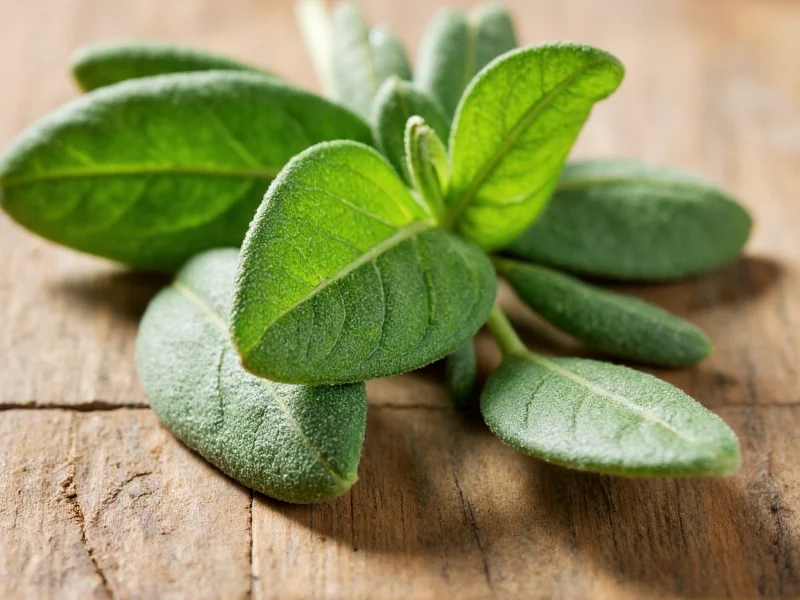Sage (Salvia officinalis) stands as one of the most distinctive herbs in the culinary world, prized for its complex flavor profile that transforms dishes with its unique character. Understanding the precise flavor of sage helps home cooks and professional chefs alike harness its full potential in the kitchen.
The Complete Sage Flavor Profile
When evaluating what does sage taste like, several key flavor dimensions emerge:
- Primary notes: Earthy, peppery, and slightly bitter with warm undertones
- Secondary characteristics: Subtle pine, eucalyptus, and faint lemon-citrus notes
- Mouthfeel: Mildly astringent with a slight numbing quality on the tongue
- Aroma profile: Woody, herbal, with medicinal undertones when crushed
The intensity of sage flavor makes it one of the more potent culinary herbs, requiring careful measurement in recipes. Unlike more delicate herbs like parsley or chives, sage maintains its flavor integrity through extended cooking times, making it ideal for slow-cooked dishes.
Fresh Sage vs Dried Sage Flavor Differences
Understanding fresh sage vs dried sage flavor characteristics proves essential for recipe success. The drying process significantly alters sage's chemical composition, creating noticeable differences:
| Characteristic | Fresh Sage | Dried Sage |
|---|---|---|
| Flavor intensity | Moderate, more nuanced | Concentrated, more potent (use ⅓ less) |
| Citrus notes | Pronounced lemon undertones | Minimal citrus presence |
| Bitterness | Mild, balanced | More pronounced |
| Best uses | Finishing dishes, butter sauces, infused oils | Long-cooked dishes, stuffings, meat rubs |
Chefs often note that dried sage develops slightly camphorous notes that aren't present in fresh leaves. This transformation occurs as volatile compounds evaporate during the drying process, concentrating the more stable terpenes responsible for sage's distinctive character.
Culinary Applications of Sage
Mastering how to use sage in recipes requires understanding its flavor interactions. Sage's robust profile makes it particularly effective in:
- Meat preparations: Its astringency cuts through rich fats in pork, duck, and sausage
- Butter sauces: Brown butter with sage creates a nutty, aromatic sauce for pasta
- Stuffings and dressings: Provides earthy backbone to holiday preparations
- Bean dishes: Complements legumes' earthiness while aiding digestion
- Cheese pairings: Works exceptionally well with sharp cheeses like pecorino
When cooking with sage tips, remember that heat intensifies its bitterness. Add fresh sage toward the end of cooking, while dried sage benefits from earlier addition to allow flavors to mellow. For optimal flavor extraction, lightly crush dried leaves between your fingers before adding to dishes.
Perfect Food Pairings for SageKnowing what foods pair well with sage helps create balanced dishes that showcase its unique profile without overwhelming other ingredients. Consider these successful combinations:
- Fall vegetables: Butternut squash, sweet potatoes, and roasted root vegetables
- Citrus elements: Lemon zest or orange segments balance sage's earthiness
- Nuts: Walnuts and pecans complement sage's woody notes
- Cheeses: Aged pecorino, Parmesan, and creamy goat cheese
- Proteins: Pork loin, duck breast, and white beans
Professional chefs often employ the "rule of three" when working with strong herbs like sage: combine it with two complementary flavors to create balance. For example, sage with lemon and garlic creates a harmonious trio that enhances rather than dominates.
Common Sage Mistakes to Avoid
Many home cooks struggle with sage flavor characteristics due to these common errors:
- Overuse: Sage's potency means a little goes a long way (start with 1-2 leaves per serving)
- Improper storage: Fresh sage loses flavor quickly when refrigerated in plastic
- Burning: Sage leaves scorch easily in hot oil, creating bitter compounds
- Using with delicate flavors: Overpowers subtle ingredients like fish or light vegetables
- Ignoring regional varieties: Different sage species offer distinct flavor profiles
For best results when cooking with sage tips, add fresh leaves to cold oil and gently warm them to release flavors without burning. This technique, called infusing, extracts maximum flavor while preventing bitterness.
Exploring Sage Varieties
While common garden sage (Salvia officinalis) dominates culinary use, other varieties offer unique flavor nuances:
- Purple sage: More floral with reduced bitterness
- Tricolor sage: Milder flavor, primarily used for visual appeal
- Pineapple sage: Distinct tropical notes with less earthiness
- Russian sage: Not true culinary sage - more ornamental with different chemistry
Understanding these variations helps select the right sage for specific culinary applications, expanding your flavor possibilities beyond standard garden sage.











 浙公网安备
33010002000092号
浙公网安备
33010002000092号 浙B2-20120091-4
浙B2-20120091-4